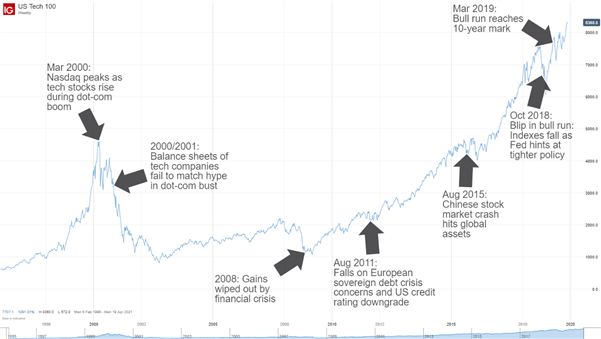The Nasdaq 100 (or US Tech 100) is one of the most followed stock indexes in the world; home to major global tech companies and providing a snapshot of both US and international economic health. Read on to find out how the index is calculated, the companies involved, and what moves the Nasdaq 100 price.
What is the Nasdaq 100?
The Nasdaq 100 is a major stock market index featuring more than 100 of the largest publicly-traded non-financial businesses on the Nasdaq composite index, the second-largest stock exchange in the world.
Since its inception in 1985, the Nasdaq 100, or US tech 100, has been determined by a weighted market capitalization system, featuring companies across sectors from tech to retail to healthcare, but not financial businesses like commercial and investment banks.
The Nasdaq 100 index is tracked by the exchange-traded fund PowerShares QQQ Trust (QQQ).
How is the Nasdaq Calculated?
The Nasdaq 100 is calculatedby market capitalization of its constituents, with the QQQ weighted heavily towards large-cap technology companies.
The value of the index is determined by the aggregate value of the index share weights of each of the index securities, multiplied by each security’s last sale price and divided by an index divisor. No company on the Nasdaq 100 can have more than a 24% weighting.
What are the Nasdaq 100 Companies?
The companies that feature in the Nasdaq index are, as mentioned, largely tech-focused, such as Apple, Google parent company Alphabet, and Intel. However, other companies of note include the likes of retailer Costco Wholesale and toymaker Hasbro. As of November 2019, the most highly-capitalized companies featured on the index are:
- Apple
- Microsoft
- Amazon
- Alphabet
- Intel
- Comcast
- Cisco
- PepsiCo
- Adobe
How do Companies Get Listed on the Nasdaq 100?
To be listed on the Nasdaq 100 index, a company must be listed on the Nasdaq Global Select Market or Nasdaq Global Market. In terms of security types, eligibility encompasses common stocks, ordinary shares, ADRs and tracking stocks.
Nasdaq-listed companies must also have an average daily volume of 200,000 shares, submit both quarterly and annual reports, be publicly offered for at least three months, and be free from bankruptcy proceedings.
Companies are reviewed quarterly and are added or removed based on the market capitalization.
History of Nasdaq 100
Since its inception in 1985, the Nasdaq has seen dramatic fluctuations in value. The base price started at 250, but enjoyed a mostly consistent rise since then, with the Nasdaq 100 price climbing above 8,000 in November 2019 as tech equities soared.
A particularly pronounced spike was during the dot-com boom around the turn of the 21st century, when the index rose above the 5,000 mark. However, the surge in popularity of tech stocks meant the index became overvalued as company balance sheets failed to live up to the hype.
The index also took a hit, along with the wider global stock market, when the financial crisis of 2008 struck, but since 2009 it has been on a dramatic bull run that mirrors other indexes such as the wider S&P 500 and the German DAX 30. Some of the other important points on the price journey are marked on the chart below.

What Factors Affect the Nasdaq 100 Price?
The factors that affect the Nasdaq 100 price are shaped by the performance of the stocks that make up the index, as well as external fundamental drivers.
1) Stock performance
Factors such as earnings reports, key appointments and new product launches can all impact a stock’s performance and price, and in turn affect the price of the wider index. The weighting system means that events affecting the largest constituents are more likely to impact the price of the wider index.
2) Fundamental factors
Broader economic factors, particularly in the US, such as interest rates, monetary policy and general economic indicators can have some effect on the index – as well as economic performance, which can affect company investment levels and consumer appetite for products.
Reasons to consider Nasdaq 100
As the best-known technology-focused index in the world, the Nasdaq 100 offers exposure to large price fluctuations, with high volatility compared to other indices. Also, the index offers strong liquidity as well as tight spreads and long trading hours.
The Nasdaq can be traded through Nasdaq futures and options, and exchange-traded funds (ETFs). DailyFX also offers more technical advice on how to trade Nasdaq, looking at strategies, expert tips and trading hours.
Further reading on the Nasdaq 100
Start your Nasdaq trading journey with the latest news and analysis, and follow the Nasdaq live chart to keep track of the latest price movements. Also, don’t miss our free equities forecast to stay abreast of the latest stocks and indices outlook from our market analysts.





